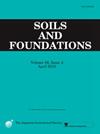推进比对承载层螺旋桩性能的影响
IF 3.3
2区 工程技术
Q2 ENGINEERING, GEOLOGICAL
引用次数: 0
摘要
如今,使用螺旋桩的优势非常明显,这提高了其在深基础领域的重要性。此外,当前的环境挑战将建筑行业引向可持续发展的方向,这为未来使用此类打桩技术创造了更多机会。因此,需要进行更多研究,以优化螺旋桩在与安装工作相关的极限承载力方面的性能。为了进一步探索,本次研究重点关注了推进比对最终承载力以及安装荷载和扭矩所做功的影响。试验采用模型比例,准备了两种地面(使用丰浦砂)来安装单螺旋式螺旋桩,即情况 I:松散砂覆盖密集砂和情况 II:松散砂。在情况 I 中,螺旋安装到 1 倍螺旋直径的致密承载层中。实验结果表明,随着推进比(从 0.25 到 1.25)的增加,安装载荷也随之增加。另一方面,安装扭矩随着推进比的增加而减小。这是由于每个螺距插入的旋转次数增加以及由此产生的沙粒移动所致。螺旋桩周围地面状态的变化与推进比和初始密度密切相关。理想的推进比(1.0)在现场很难达到,因为压载需求很高;我们开发了经验公式,可用于估算极限承载力的增加/减少以及初始设计阶段所需的相关安装工作量。本文章由计算机程序翻译,如有差异,请以英文原文为准。
Advancement ratio effect on screw pile performance in the bearing layer
The advantages of using screw piles are quite evident nowadays, which enhances its importance in the field of deep foundations. Moreover, the current environmental challenges direct the construction industry towards sustainability, creating more opportunities for such type of piling techniques to be used in the future. Therefore, more investigation is required to optimise screw pile performance in terms of ultimate bearing capacity associated with installation efforts. To explore further, the current study focused on the effect of the advancement ratio on ultimate bearing capacity and work done due to installation load and torque. The model scale of testing is adopted, and two kinds of ground (using Toyoura sand), i.e., scenario I: loose sand over dense sand and scenario II: loose sand, are prepared to install the single helix screw pile. In the case of scenario I, the screw is installed up to 1 times the helix diameter into the dense bearing layer. Based on the experimental results, it was observed that as the advancement ratio (from 0.25 to 1.25) increased, the installation load also increased. On the other hand, the installation torque decreased with the increase in advancement ratio. This was due to the increase in the number of rotations per pitch penetration and the resultant movement of sand particles. The change in the state of the ground around the screw pile is strongly related to the advancement ratio and initial density. The ideal advancement ratio (1.0) is difficult to attain in the field due to high pressing load demand; empirical equations are developed, which can be used to estimate the increase/decrease of ultimate bearing capacity and associated installation requirements in terms of work done for the initial design stage.
求助全文
通过发布文献求助,成功后即可免费获取论文全文。
去求助
来源期刊

Soils and Foundations
工程技术-地球科学综合
CiteScore
6.40
自引率
8.10%
发文量
99
审稿时长
5 months
期刊介绍:
Soils and Foundations is one of the leading journals in the field of soil mechanics and geotechnical engineering. It is the official journal of the Japanese Geotechnical Society (JGS)., The journal publishes a variety of original research paper, technical reports, technical notes, as well as the state-of-the-art reports upon invitation by the Editor, in the fields of soil and rock mechanics, geotechnical engineering, and environmental geotechnics. Since the publication of Volume 1, No.1 issue in June 1960, Soils and Foundations will celebrate the 60th anniversary in the year of 2020.
Soils and Foundations welcomes theoretical as well as practical work associated with the aforementioned field(s). Case studies that describe the original and interdisciplinary work applicable to geotechnical engineering are particularly encouraged. Discussions to each of the published articles are also welcomed in order to provide an avenue in which opinions of peers may be fed back or exchanged. In providing latest expertise on a specific topic, one issue out of six per year on average was allocated to include selected papers from the International Symposia which were held in Japan as well as overseas.
 求助内容:
求助内容: 应助结果提醒方式:
应助结果提醒方式:


